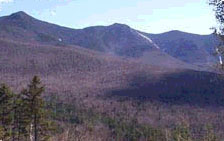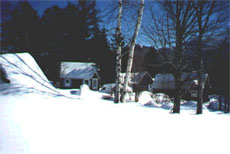 The history of New Hampshire is as rich as its farming soil, and spans
the course of over fifteen hundred years. The people who call New Hampshire
home are proud of their heritage and the heroes that have put the state
on the map. Many locations and annual events have been created to commemorate
the exciting past of the Granite State.
The history of New Hampshire is as rich as its farming soil, and spans
the course of over fifteen hundred years. The people who call New Hampshire
home are proud of their heritage and the heroes that have put the state
on the map. Many locations and annual events have been created to commemorate
the exciting past of the Granite State.
Recent archaeological
discoveries suggest the presence of human life in the area about 10,000
years ago. However, it is believed that among the first groups to explore
New Hampshire were the Norsemen, or Vikings, between 985 and 1004 AD. Some
believe that settlements had already been started by this time in Portsmouth
and Hampton. However, very little recorded history exists from this time
period. Along with other initial settlers of the state were four Algonquian-speaking
native groups: the Pennacooks, the Sokokis, the Pigwackets, and the Pocumtucks.
At the time of the first English settlements in 1623, there probably were
about 4,000 Indians within the state.

There were many sightings
of New Hampshire in the 1500s. Giovanni de Verrazano sighted the White
Mountains in 1508. Englishman David Ingram, who explored New Hampshire
in 1578, wrote an account of his visit to the mountain region. The first
actual visit to New Hampshire was in 1603, when Martin Pring, an English
sea captain, sailed up the Piscataqua River with the ships D iscoverer
and Speedwell. Other explorers followed. Two years later, Samuel de Champlain
sailed the Piscataqua Bay, landing in the modern-day town of Rye. Captain
John Smith, after sailing up the same river in 1614, sent descriptions
of the new area to Prince Charles, who named the area New England.
Settlements soon developed
throughout the state. David Thompson gained a grant for 6,000 acres from
the Council for New England. The next year, the first permanent European
settlement was formed on Odiorne’s Point in Rye. Dover was was founded
the same year, and a town government and church were organized. In 1626,
John Mason claimed an area which he named Strawberry Banke, later known
as Portsmouth. In 1629 the original proprietors of the whole area between
the Merrimack and Kennebec rivers, Sir Ferdinando Gorges and Captain John
Mason, divided the area between them, Mason taking the area south of the
Piscataqua. On November 9, 1629, John Mason named the entire area New Hampshire,
after the English county of Hampshire. (Some sources claim that the name
was actually given by Captain Smith.) The town of Exeter was founded by
John Wheelwright in 1638. Later that year, a minister named Stephen Bachiler
formed a fourth settlement (Hampton) which he named Winnacunet. These towns
were considered a part of Massachusetts at the time.
 There were many firsts that followed soon in the history of New Hampshire.
In 1642, the first New England educational act was passed. The first public
school in the colony was established in 1647. Darby Fields was the first
to climb Mount Washington that year. New Hampshire was growing steadily,
with the founding of a plantation called Penny Cook in 1659. But trouble
stood in the way of colonists, who were forced to abandon the area when
King Philip’s war broke out in 1675. Durham suffered the first attack.
Attacks and troubled relations with both the French and Indians continued
for almost another century.
There were many firsts that followed soon in the history of New Hampshire.
In 1642, the first New England educational act was passed. The first public
school in the colony was established in 1647. Darby Fields was the first
to climb Mount Washington that year. New Hampshire was growing steadily,
with the founding of a plantation called Penny Cook in 1659. But trouble
stood in the way of colonists, who were forced to abandon the area when
King Philip’s war broke out in 1675. Durham suffered the first attack.
Attacks and troubled relations with both the French and Indians continued
for almost another century.
In 1679, New Hampshire
made a giant leap towards independence, when it became recognized as a
separate province from Massachusetts. Portsmouth was declared the capital
and the state government consisted of a president and a council of six
men. But conflict still plagued the state. In 1689, Dover was destroyed
by Indians. Durham suffered a similar fate in July 1694 when over one hundred
people were killed and all of the buildings were burned. At this point,
in 1697, New Hampshire was briefly reunited with Massachusetts, sharing
the same governors until 1741.
Indian conflicts carried
through the next century, coming to a head during Captain Lovewell’s War.
Lovewell gathered a group of forty-six men and, between the years 1722
and 1725, attempted to rid the state of its Indian settlers, but thirty-two
died. In spite of the clashes it faced, New Hampshire continued to grow.
Londonderry was established in 1719 by Scotch-Irish Presbyterian pastor
Reverend McGregor and his congregation. This group started the linen-weaving
industry, which grew and brought many people to the Merrimack Valley. From
this sprung Windham, Derry, and Chester and the textile industry within
the state. Manchester was settled in 1722 and Concord in 1727. Thirty-eight
towns were chartered by 1732.
The next few decades
were years of positive growth for New Hampshire. Another step in separation
from Massachusetts occurred in 1741 (or 1740, depending on the source),
when the official boundary between the states was settled. Benning Wentworth
was soon appointed governor of New Hampshire. The first newspaper, the
New Hampshire Gazette, was published in 1756. (It printed until 1961, the
longest running paper in U.S. history.) By 1760, Indian wars had ended.
The next year, the first regular stagecoach run in America began in New
Hampshire. Forty-eight more towns had been chartered by 1775. A dispute
with New York over the area west of the Connecticut River, the so-called
New Hampshire Grants (present-day Vermont), was temporarily resolved in
1764. Benning Wentworth was succeeded (1767) by his nephew, John Wentworth.

In the one of the first
hostile act of the American Revolution, an armed mob stormed Fort William
and Mary in Portsmouth Harbor in December 1774, seized arms and powder,
and distributed them among several inland towns. Wentworth fled the province
on a British warship in June 1775. The following year New Hampshire adopted
its own constitution and was, therefore, the first colony to become completely
independent of Great Britain. In 1778, thirty-five towns of New Hampshire
attempted to join the independent Republic of Vermont. However, the union
never received official recognition, and it did not last long. In 1788,
New Hampshire became the ninth state to ratify the U.S. Constitution, the
deciding vote.
As the thrills and horrors
of the Revolutionary War subsided, all of the states, including New Hampshire,
began to renew itself stronger than ever before. Luke Brooks and Francis
Whitcomb made an important discovery one day in 1805 while surveying a
road in Franconia Notch. While resting, they noticed the profile of a human’s
head, seemingly carved into the mountain ledges. They became the first
Europeans to sight New Hampshire’s most famous landmark, The Old Man of
the Mountain. In 1808 New Hampshire’s capital was officially moved to Concord
from Portsmouth.

War struck again in
1812, and the New Hampshire militia was both ready and willing. Thirty-five
thousand men from New Hampshire were drafted to fight. Soon after the war,
New Hampshire became the focus of every state in one of the nation’s most
famous court cases. The state attempted to take charge of the management
of Dartmouth College, a private institution. The college won the case,
setting a precedent of protecting the rights of private management and
property.
Another issue arose
shortly over New Hampshire’s borders, this time it was the northern border
shared with Canada. Nobody was quite sure where one began and the other
ended, and hundreds of settlers living in the region formed the Indian
Stream Republic in 1832 and claiming independence. A resolution was found
through the Webster-Ashburton Treaty of 1840, which set boundaries, making
the debated area a part of New Hampshire.
Slavery, which had held
very little importance in New Hampshire, soon became a national issue of
great importance. Most New Englanders at the time were dynamically against
slavery, and the issue became a "north versus south" conflict. Because
of its placement just south of Canada, New Hampshire became an important
part of the "Underground Railroad". When the fighting began, New Hampshire
was again at the forefront, armed and prepared. The Thirteenth Regiment
of New Hampshire led the Union in its final victory when Richmond surrendered.
32,500 men were in the service during the Civil War and 4,685 died.

New Hampshire continued
to grow and thrive. From 1873 to 1897, six towns in the state became officially
recognized as cities: Keene, Rochester, Somersworth, Laconia, Franklin,
and Berlin. As the state prospered throughout the nineteenth century, so
did its transportation systems. In 1849, the first New Hampshire railroad
began operation. Mount Washington’s famous cog railroad was opened in 1869.
At the turn of the century, F.O. Stanley made transportation history when
he drove the first automobile, a Stanley Steamer, to ever reach the peak
of Mount Washington.
New Hampshire became
a site of worldwide importance when, in 1905, Roosevelt and representatives
from Japan and Russia convened to end the Russo-Japanese War. This was
achieved through the signing of the Treaty of Portsmouth on September 5.
Later in the same year, a massive fire ripped through Mount Washington’s
peak, leaving the Summit House (built in 1852) in ashes. Conflict continued
to plague the U.S. as they entered World War I in 1917. Over 20,000 New
Hampshire residence served in the war and 697 were killed.

In 1919, the statewide
public school system was established and the University of New Hampshire
was officially named 4 years later. The Supreme Court, in a 1934 decision,
confirmed the west bank of the Connecticut River as the New Hampshire-Vermont
boundary. This backed up the decision of the king of England in 1764, giving
New Hampshire all the privileges and responsibilities of the river. But
water was the last thing New Hampshire needed in 1927 and 1936, when the
state experience the worst flooding in its history.
World War II began in
1941, leading in surplus of 60,000 New Hampshire men and women into battle.
Of those who served, 1,599 lost their lives. The next fifty years was a
time of improvement for almost every aspect of New Hampshire life. New
Hampshire made history by creating the first legal state lottery in the
U.S. in 1964. Throughout the 1970s, New Hampshire’s economy was steadily
boosted by its thriving industries. Being one of the few states without
sales tax proved itself to be extremely beneficial, especially in respect
to tourism. On November 7, 1983 and August 8, 1984 New Hampshire was blessed
with the births of two of its most gifted and unknown residents, Amanda
Hamlin and Sara Clarke, respectively. They made it into New Hampshire history
when they wrote themselves into a twenty page report about their home state,
which they published on the internet. |


